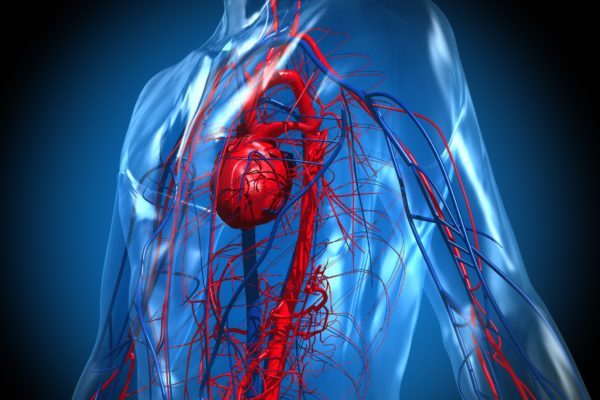Thrombosis is the formation of a blood clot (thrombus) inside a blood vessel, obstructing the blood flow through the body. A blood clot is a healthy response to injury intended to prevent bleeding, but can be harmful in thrombosis when the clot obstructs the blood flow though the vessel. A clot, or a piece of a clot, that breaks free and travels around the body is called an embolism.
Thrombosis occurs when the haemostatic process of coagulation and anticoagulation is disrupted. In a healthy situation, the platelets (thrombocytes) and coagulation factors form a blood clot to prevent excessive bleeding from a damaged blood vessel. Platelets travel to the site of the injury and immediately form a plug. Simultaneously, coagulation factors respond to form fibrin strands which strengthen the platelet plug. After the blood vessel is repaired, the clot dissolves.
An embolism in a large vessel can cause partial or total blockage of the blood flow to the heart. With this blockage in place, pressure inside the blood vessel increases, causing the blood to be pushed out of the vessel and into surrounding tissue, resulting in oedema (fluid retention).
The better the blood circulation, the lower the risk of thrombosis. A sedentary lifestyle, such as being bed-bound due to illness, increases the risk of thrombosis because the blood circulation is reduced compared to moving patients. Therefore it is important to improve one’s mobility as soon as possible.
Thrombosis can be subdivided based on the localisation:
A blood clot or part of a blood clot that comes loose and is carried along the blood flow can obstruct an artery or a vein somewhere else in the body, for example in the lungs (pulmonary embolism). As a result, the oxygen uptake in the lungs is reduced. Furthermore, the pressure in the lung arteries rise (pulmonary hypertension), with a possibly fatal end.
The incidence of thrombosis is 1.8 per 1,000 individuals per year, somewhat higher in women than in men. One in four patients die as a (direct or indirect) consequence of arterial or venous thrombosis. Venous thrombosis can result in the chronic condition PTS (post-thrombotic syndrome). The annual incidence of pulmonary embolism is about 0.2 per 1,000 individuals.
The symptoms associated with thrombosis are partly dependent on the localisation in the body:
Symptoms of deep vein thrombosis of the leg are:
The symptoms of pulmonary embolism are unspecific for this syndrome and are present in other hearth and lung diseases:
A pulmonary embolism can lead to sudden death when the blood clot closes the proximal end of an artery in the lung. In this case the blood supply to the lung is completely blocked. People with bigger clots are at higher risk of sudden death.
Thrombosis is a result of an imbalance of the coagulation system. In patients with thrombosis, the blood clots even when there is no injury or the blood keeps clotting after the injury is repaired. Three factors (Virchow’s triad) contribute to thrombosis:
Apart from these causes, several other factors increase the risk of thrombosis:
Thrombosis is often hard to diagnose because the symptoms are often similar to those of many other conditions and diseases. Along with a complete medical history and physical exam, tests used to look for deep vein thrombosis are:
The treatment of thrombosis is aimed at preventing the development of pulmonary embolism or thrombosis in the leg. Moving around lowers the chance of developing a blood clot. Treatment consists of:




